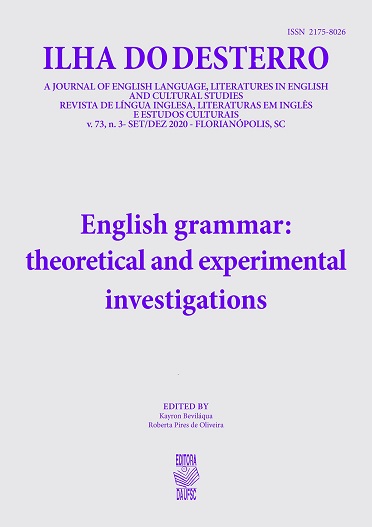Intonational effects on English scopally-ambiguous sentences
DOI:
https://doi.org/10.5007/2175-8026.2020v73n3p13Abstract
This paper examines the effect of intonation contour on two types of scopally ambiguous constructions in English: configurations with a universal quantifier in subject position and sentential negation (e.g., Every horse didn’t jump) and configurations with quantifiers in both subject and object positions (e.g., A girl saw every boy). There is much prior literature on the relationship between the fall-rise intonation and availability of inverse scope with quantifier-negation configurations. The present study has two objectives: (1) to examine whether the role of intonation in facilitating inverse scope is restricted to this configuration, or whether it extends to double-quantifier configurations as well; and (2) to examine whether fall-rise intonation fully disambiguates the sentence, or only facilitates inverse scope. These questions were investigated experimentally, via an auditory acceptability judgment task, in which native English speakers rated the acceptability of auditorily presented sentences in contexts matching surface-scope vs. inverse-scope readings. The results provide evidence that fall-rise intonation facilitates the inverse-scope readings of English quantifier-negation configurations (supporting findings from prior literature), but not those of double-quantifier configurations.
References
Anderson, C. (2004). The structure and real-time comprehension of quantifier scope ambiguity. (Doctoral dissertation ), Northwestern University Evanston, IL.
Bolinger, D. L. (1958). Intonation and grammar. Language Learning, 8(1‐2), 31-37. doi:10.1111/j.1467-1770.1958.tb01214.x
Bott, O., & Schlotterbeck, F. (2012). Incremental Truth Value Judgments. In B. Stolterfoht & S. Featherston (Eds.), Empirical approaches to linguistic theory. Berlin: Mouton de Gruyter.
Büring, D. (1997a). The great scope inversion conspiracy. Linguistics and Philosophy 20, 175-194.
Büring, D. (1997b). The meaning of topic and focus: the 59th Street Bridge accent. London, UK: Routledge.
Christensen, R. H. B. (2018). ordinal - Regression models for ordinal data. R package version 2018.4-19. http://www.cran.r-project.org/package=ordinal/
Fox, D. (2000). Economy and Semantic Interpretation. Cambridge, Massachusetts: MIT press.
Frey, W. (1993). Syntaktische Bedingungen für die semantische Repräsentation:Über Bindung, implizite Argumente und Skopus. Berlin: Akademie Verlag
Ionin, T., & Luchkina, T. (2015). The relationship between quantifier scope and information structure in Russian: an experimental perspective. Paper presented at the XPrag 2015, Chicago, IL.
Ionin, T., & Luchkina, T. (2017). The one kitten who was stroked by every girl: revisiting scope and scrambling in Russian. In C. Halpert, H. Kotek, & C. van Urk (Eds.), A pesky set: Papers for David Pesetsky. Cambridge, MA: MIT Working Papers in Linguistics.
Ionin, T., & Luchkina, T. (2018). Focus on Russian scope: An experimental investigation of the relationship between quantifier scope, prosody, and information structure. Linguistic Inquiry, 49(4), 741-779.
Ionin, T., & Luchkina, T. (2019). Scope, syntax and prosody in Russian as a second or heritage language. In J. Camacho & M. Cabrera (Eds.), Exploring interfaces: Lexicon, syntax, semantics and sound. Cambridge, UK: Cambridge University Press.
Jackendoff, R. (1972). Semantic interpretation in generative grammar Cambridge, MA: MIT Press
Jacobs, J. (1982). Syntax und Semantik der Negation in Deutschen. Munich, Germany Wilhelm Fink Verlag
Jacobs, J. (1983). Fokus un Skalen: Zur Syntax und Semantik der Gradpartikeln im Deutschen Tübingen, Germany: Max Niemeyer Verlag
Jacobs, J. (1984). Funktionale Sazperspektiven und Illokutionssemantik. Linguistische Berichte, 91, 25-58.
Krifka, M. (1998). Scope inversion under the rise-fall contour in German. Linguistic Inquiry, 29, 75-112
Ladd, D. R. J. (1980). The structure of intonational meaning: Evidence from English.: Indiana University Press.
Lee, W. R. (1955). English intonation: A new approach. Lingua, 5, 345-371. doi:https://doi.org/10.1016/0024-3841(55)90028-0
Lenth, R. (2018). Emmeans: Estimated marginal means, aka least-squares means. R Package, Version 1(2).
Liberman, M., & Sag, I. (1974). Prosodic form and discourse function. In Proceedings of CLS 10 (pp. 416-427). Chicago: Chicago Linguistic Society.
May, R. (1977). The Grammar of Quantification. Cambridge, Massachusetts.
Musolino, J., Crain, S., & Thornton, R. (2000). Navigating negative quantificational space. In Linguistics (Vol. 38, pp. 1-32).
Musolino, J., & Lidz, J. (2006). Why children aren't universally successful with quantification. Linguistics, 44(4), 817-852. doi:10.1515/LING.2006.026
Scontras, G., Polinsky, M., Tsai, C.-Y. E., & Mai, K. (2017). Cross-linguistic scope ambiguity: When two systems meet. Glossa 2(1), 36.31-28.
Syrett, K., Simon, G., & Nisula, K. (2014a). Prosodic disambiguation of scopally ambiguous quantificational sentences in a discourse context. Journal of Linguistics, 50(2), 453-493. doi:10.1017/S0022226714000012
Syrett, K., Simon, G., & Nisula, K. (2014b). Prosodic disambiguation of scopallyambiguous sentence. In NELS 43 Proceedings.
Tunstall, S. (1998). The interpretation of quantifiers: Semantics and processing. (Doctoral Dissertation ), University of Massachusetts at Amherst,
Ward, G., & Hirschberg, J. (1985). Implicating uncertainty: The pragmatics of fall-rise intonation. Language, 61(4), 747-776. doi:10.2307/414489
Downloads
Published
Issue
Section
License
Copyright (c) 2020 Mien-Jen Wu, Tania Ionin

This work is licensed under a Creative Commons Attribution 4.0 International License.

This work is licensed under a Creative Commons Attribution 4.0 International License.



